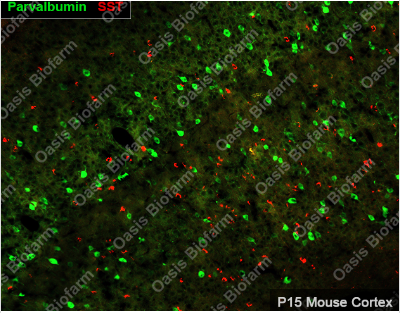
Parvalbumin Rat pAb
產(chǎn)品介紹
產(chǎn)品屬性
Guinea pig-anti-Parvalbumin antibody
Catalog No: OB-PGP005
RRID: AB_2938894
Host Species: Guinea pig polyclonal antibodies
Important Notice: Antigen retrieval is recommended.
Gene Synonyms: Pvalb, parvalbumin, Parv, PV, Pva
Species Reactivity: Mouse, rat, human, dog; Predict to work in primates
Applications: IF/IHC-Fr: 1:500~2000 IHC-P: 1:500~2000 WB: 1:2000~5000
Antigen Retrieval: For an alternative approach, tissue sections could be incubated in 1x Citrate antigen retrieval solution for 30 min at 85~95°C and cool down to room temperature before next procedure.
Immunogen: Mouse Pavlb peptide fused to GST.
Purification: Affinity purification
General Notes: FOR RESEARCH USE ONLY
Storage Buffer: pH7.4, PBS, 55mM Tris, 50mM Glycine, ~40% Glycerol, 0.1% potassium sorbate
Storage: Shipped at 4°C. Store at -20/4°C for months and -80°C for years. Avoid freeze/thaw cycle.
Background: Parvalbumins are small calcium-binding proteins, members of the EF-hand protein family, that are expressed in vertebrates. Particularly abundant in certain skeletal muscle fibers and neurons, parvalbumins function primarily as mobile cytosolic Ca2+ buffers. They influence the duration of intracellular Ca2+ signals and play key roles in muscle relaxation following contraction and neuronal recovery following excitation [1]. Mice homozygous for deletion of this marker show slower cotraction-relaxation of fast twitch muscle and increased force generation. Abnormalities are also reported in Purkinje cell morphology [2, 3]. In the neocortex region, expressing cells represent the largest category of inhibitory interneurons (~30%–50%) [4, 5].
[1] Pauls TL, et al. Biochim Biophys Acta. 1996; DIO: 10.1016/0167-4781(95)00221-9
[2] Chen G, et al. Neuroscience. 2006; DIO: 10.1016/j.neuroscience.2006.06.008
[3] Schwaller B, et al. Am J Physiol. 1999; DIO: 10.1152/ajpcell.1999.276.2.C395
[4] Rudy B, et al. Dev Neurobiol. 2011; DIO: 10.1002/dneu.20853
[5] Nichols J, et al. J Physiol. 2018; DIO: 10.1113/jp275393
Key Words: Cortical interneurons, basket cells, inhibitory interneurons, GABAergic interneurons






